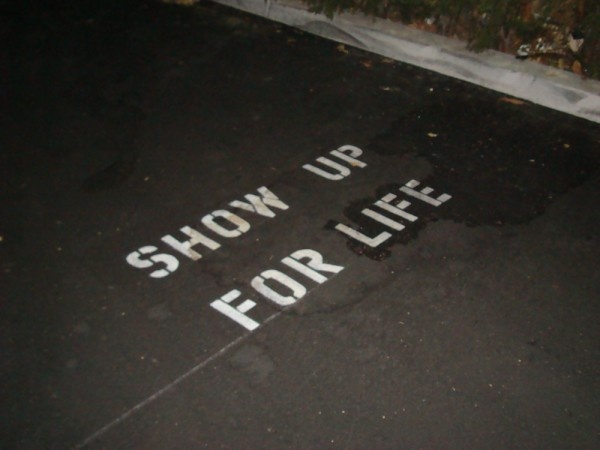
Showing Up for Life
Here’s the bottom line of what I want to say and then we’re going to back into it: to fully live life, to fully engage the spiritual journey and grow into a wise, emotionally healthy, centered, compassionate human beings, we have to not only show up for life, but we have to lean into both the joy and the discomfort.
Woody Allen said that 80% of life is simply showing up, but I don't think that simply occupying space in any given situation is really enough.
In John 11, Lazarus, a good friend of Jesus’ has recently died and when Jesus finally arrived, he wept. He wasn't stoic, or dismissive (since he was about to bring him back to life), instead he allowed himself to be vulnerable, to open his heart to the pain of the family and his own pain. Jesus not only showed up, but leaned into his feelings. This man that we look up to for his compassion, love, kindness, forgiveness, gentleness and generosity was also not afraid to feel, to show his sadness, to meet it head on.
So, if we're honest with ourselves, what is our first reaction when something bad happens? Many times I think we wish we simply didn't have to deal with it. Can we just make it go away? We’re a culture that doesn’t deal well with difficult situations. And, I worry that the up and coming generation will be worse. It’s too easy use texts and email to deal with conflict. I tell my kids over and over, if you have to deal with a difficult situation you must do it in person, or at least over the phone. We have to lean into the discomfort to deal with it in a responsible way. No, it might not be fun, but it builds character, wisdom and helps us grow.
Brene’ Brown, in her book Daring Greatly, talks about our culture’s propensity for numbing our pain. Extreme numbing takes the form of addiction. Did you know that in 2017 (according to the National Survey on Drug Use and Health, 19.7 million American adults (aged 12 and older) battled a substance use disorder? Plus there were 66.6 million binge drinkers and 16.7 million heavy drinkers. But there are many other ways to numb or, as she says, to “take the edge off,” including eating, exercise, retail therapy, cleaning, burying yourself in work, Netflix and Facebook, or even religion.
Sure, sometimes it is good to calm down a little, maybe even using some of these methods, to come at problems from a better perspective. Numbing is different; it means an indefinite escape if at all possible. It’s an avoidance measure.
Here’s another thought. We’re not just numbing for the crises and tragedies of life – death, illness, job loss, break-ups. We’re also numbing the pain from feeling inadequate and “less than.” We’re numbing because of anxiety and disconnection, loneliness, isolation, disengagement and emptiness.
So, numbing is a problem for a few different reasons.
First, numbing really doesn’t work all that well, because people leak. If you don’t process your grief, for example, and clear it or work through it, that pain will erupt out of you in different ways and you’ll take it out on other people, or your pet or the poor unsuspectinggrocery store attendant. If you don’t process and deal with a bad relationship, you’re bound to repeat that mistake until you do.
Someone recently said to me that you have to clean your emotional hurts as well as you’d clean a wound to keep it from getting infected. Our emotional wounds, unattended and unhealed, will simply continue to cause pain.
Second, as Brown said, we don’t get to be selective about what we numb. You can’t block out one or two colors of the rainbow, without blocking the whole thing. We can’t simply choose to fully embrace joy while numbing sadness and hurt. Numbing is numbing… you dull all of it.
So, where’s the line between pleasure or comfort, and numbing? The difference is the intention… why do you do it. You can eat a piece of chocolate because you love the sweetness, or you eat a whole box of bon bons in an attempt to soothe yourself. You can peruse Facebook for a bit as a break from work, or you can peruse FB to avoid talking to your partner about something that is bothering you.
Interestingly enough, Brown names spirituality as a key in developing the resilience to show up and lean into the uncomfortable times in life. Let me be clear that she is talking about spirituality NOT RELIGION. Spirituality being a belief in, and a connection to, something greater than ourselves and the understanding that we’re all ONE, we’re all in this together.
We numb when we experience fear, blame, shame, hopelessness, pain, discomfort, vulnerability and disconnection. Digging deep into our own spirituality, developing a growing relationship with the Essence That Underlies All Things, may be the only real way to feel grounded and sustained through everything. That connection can’t ever be severed (it can be forgotten, but not severed), and that connection helps us to maintain a sense of worthiness, purpose and meaning, which helps us to meet the adversities in life.
When riding the roller coaster of life we don't quite know what each day will bring. But, it is important that we show up and engage whatever life throws at us. Numbing doesn't work, we need to be present, mindful and aware to learn and grow.
Love & Light!
Kaye



